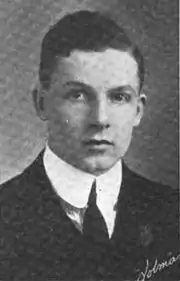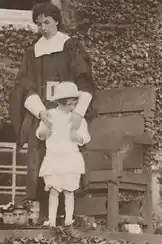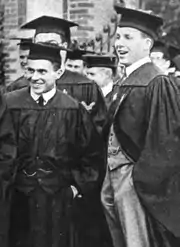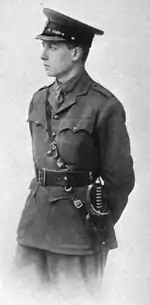Lionel de Jersey Harvard | |
|---|---|
 As a Harvard senior | |
| Born | 3 June 1893 |
| Died | 30 March 1918 (aged 24) Arras, France |
| Cause of death | Killed in action |
| Resting place | Boisleux-au-Mont[1] |
| Nationality | English |
| Education | B.A. (English, cum laude) |
| Alma mater | Harvard College |
| Known for | The first Harvard to attend Harvard |
| Spouse | May (Barker) Harvard |
| Children | John Peter de Jersey Harvard |
| Parent(s) | Thomas Mawson Harvard Maud de Jersey (Thompson) Harvard[1] |
| Relatives | Kenneth O'Gorman Harvard (brother) |
| Awards |
|
| Signature | |
 | |
Lionel de Jersey Harvard (3 June 1893 – 30 March 1918) was a young Englishman who, discovered to be collaterally descended from Harvard College founder John Harvard, was consequently offered the opportunity to attend that university, from which he graduated in 1915. The first Harvard to attend Harvard, he died in the First World War less than three years later, leaving a wife and infant son.
After his death a fellow Army officer wrote, "If Harvard College made him what he was, I want my sons to go there that it may do the same for them." Harvard's Lionel Hall, and its Lionel de Jersey Harvard Scholarship, are named in his honour.
Background
In 1908 editor Mark A. De Wolfe Howe discovered an 1847 letter[1] in which Harvard President Edward Everett makes reference to a "Reverend John Harvard" living at the time in Plymouth, England, calling him "a Wesleyan clergyman whose ancestor ... was a brother of our founder".[3] Inquiries led to the identification of London businessman[4] Thomas Mawson Harvard as the youngest son of this nineteenth-century Reverend John Harvard (1819–1888),[1][2] through whom he was descended from Thomas Harvard (1609–1637), brother[5] of Harvard University founder John Harvard (1607–1638), who had died childless.[4]
Thomas Mawson Harvard's elder son Lionel de Jersey Harvard (called "Leo" by his family)[6] was at the time attending St Olave's and St Saviour's Grammar School in Southwark—the successor to St Saviour's Grammar School, which John Harvard had himself attended.[note 1] Also like John Harvard, many in Lionel's line had attended Emmanuel College, Cambridge and become ministers.[5] On his leaving St Olave's, however, the family's finances ruled out any ambition to attend Emmanuel College himself, and so he took employment with a firm of marine insurance brokers.
In 1910 a group of Harvard alumni offered to underwrite Lionel's attendance at Harvard College,[note 2] which itself waived the tuition of $150 per year. He failed his first attempt at the entrance exam, but after a year of refresher study he qualified, and "set out for Cambridge, Massachusetts in lieu of Cambridge, England", as his friend John Paulding Brown put it later.[note 3]
Harvard College

The "sentimental and romantic" [4] story of "how Mother Harvard sought and found one of her own" [9] was reported throughout the United States,[10] and on 26 September 1911 the Boston Transcript announced, "Harvard of Harvard Here".[11] "He had the time of his life getting safely ashore [past] reporters and camera artists", said The Cambridge Tribune. "Apparently the one thing he does not wish is notoriety of any kind." [12] Howe later wrote that "it seemed like the realization of a fairy-tale ... Our local newspapers did everything in their power to spoil him, if he had been spoilable. His arrival and history were glaringly chronicled."[1] His freshman rooms were in Weld Hall.[11]
He was a good student if not brilliant, and one of the most popular members of his class;[13][5]: 13-14 Brown called him "a little different from the boys who come up each year as Freshmen, more gentle, perhaps, and more self-controlled." [14]: 531 He belonged to the Hasty Pudding and D.U. Clubs, Delta Kappa Epsilon, the Signet Society, the Glee Club, the Dramatic, Musical and Cosmopolitan Clubs, the Social Service Committee of Phillips Brooks House, the Chapel Choir, the Memorial Society, and the Christian Association; and was an officer of several of these.[1] Though on arrival he had told reporters that he played soccer and tennis, and wanted to learn baseball and American football,[11] his participation in organized athletics was limited to class crew.[1]: 201 [5]: 13
His junior-year recitation of Alfred Noyes' "The Highwayman" won him the Boylston Prize,[15] and after he portrayed John Harvard in a pageant celebrating the 150th anniversary of Hollis Hall[16][17] his classmates began calling him John.[1] "Great was the applause whenever the [Harvard Glee Club] broke into, 'Here's to Johnny Harvard, fill him up a glass, Fill him up a glass to his name and fame,' for there he was in person. [He] seemed a living symbol of all that was best and brightest in Harvard itself, manifested to us briefly after three hundred years."[note 4]
Commencement

Graduating cum laude in English[20] in June 1915, he was selected to compose both the Class Poem and the Baccalaurete Hymn.[6] His poem was "a stirring lyric adjuring all Harvard men in the present crisis of civilization [i.e. World War I] to stand for their historic ideals of freedom":[21]
A call to arms rings out today / Far loftier than of steel,The arms of the strong man girt with truth / To guard God's commonweal.[22]
His hymn reflected similar themes:
Forward we go from out these hallowed walls, / Fearless with Thee where'er our duty calls;
Speaking to the Alumni Association immediately after receiving his diploma he said, "I have had four years here full to the brim of happiness and ever-increasing joy ... I can never say enough in gratitude. When I say 'Thank you!' that word was never charged with more fervor." [25] He later wrote to Howe:
I have never been able to find out who were the gentlemen who have been so generously looking after me in money matters whilst I have been in Cambridge. It has been awfully generous of them, and I do appreciate it. I hope I shall be able to repay the kindness of you all in many more ways than one.[1]
Army, marriage, and death


Harvard planned to become a medical missionary, but on returning to London immediately after graduation he enlisted in the British Army.[5]: 14 "It is all of a piece with the devotion which the best young men of Europe are rendering to their flags," said the Harvard Alumni Bulletin.[26] He joined the Inns of Court Officers' Training Corps on 12 July 1915[27] and was commissioned a second lieutenant in the Grenadier Guards on 28 September.[28] He was promoted to lieutenant in January 1916[29] and joined the 1st Battalion in France on 8 March 1916.[30]
On 11 September 1915[1] he married childhood friend (Edith) May Barker,[5] to whom he had been quietly engaged since before leaving for America.[31] A son, John Peter de Jersey Harvard,[1][32] was born 4 September 1916.[33] Lionel was shot in the chest on 25 September 1916 at Lesboeufs during the Battle of the Somme[34]: 125 [35] but after a long convalescence he returned to combat in June 1917, as company commander.[1]
At the outbreak of the war, Lionel's younger brother Kenneth O'Gorman Harvard (born 4 June 1897)[2] gave up his intention to attend Harvard College.[14] He was commissioned August 1915[36] and, with Lionel, was promoted to lieutenant in the Grenadier Guards in January 1916.[14][29] He was killed at Pilckem Ridge, during the Battle of Passchendaele, on 1 August 1917;[1] Lionel, who had been fighting nearby, helped bury him.[5]
By March 1918 Lionel Harvard was commander of Number One Company, designated the King's Company—as Brown put it, "a high honor for a lieutenant, and usually a fatal one".[5]: 16 On the morning of 30 March 1918 he was killed by a minenwerfer shell[34] near Arras during the German spring offensive, just before a promotion to captain became effective.[1][37] He was buried at Boisleux-au-Mont.[38]
Tributes and legacy


In 1919 poet Harry Webb Farrington published a hymn, "Lionel de Jersey Harvard", including the lines:
For hallowed halls, which bear his name, / Have felt his foot and heard his voice,And sent him forth, not gowned / In student black and mortar boardBut khaki-clad with helmet steel.[39]
Harvard President Abbott Lawrence Lowell called Lionel Harvard's death "a great personal loss", noting that Lionel, like John Harvard, died just three years after taking his degree;[14] Lowell's personal gift of $110,000[40] built Lionel Hall (1925) as a memorial.[note 5] In his 1923 Commencement address, Lowell related a letter written by a British officer seeking advice on preparing his sons for Harvard College. In Lowell's telling, this officer explained that near the end of the war, he had
come into contact with an officer in the next sector of the line who told me that he was a graduate of Harvard College, whose name he bore. He told me what it had done for him. I never saw his face clearly while he was alive, for I met him only at night, and I never saw him by daylight until after he had been killed, a few days later. But if Harvard College made him what he was, I want my sons to go there that it may do the same for them.[43]
Lionel and Kenneth were remembered on the memorial at their first school, Malvern House School, Lewisham Park (destroyed in an air raid during World War II) and on a memorial at the Wesleyan Church (now demolished) at Sydenham.[44] In 1923 the Associated Harvard Clubs established the Lionel de Jersey Harvard Scholarship,[45] which annually funds a year's study at Emmanuel College by a Harvard College graduate.[note 6]
There was discussion of arranging for Lionel's son John Peter to follow his father to Harvard,[13] but after he attended the school's tercentenary celebration as a guest in September 1936, Time reported that he would likely continue his education in England.[note 7] As a major in the Royal Artillery during World War II he survived imprisonment by the Japanese after being captured in the Battle of Singapore.[5]
A second Harvard, John Harvard of Andes, New York, graduated cum laude from Harvard College in 1969.[49][50]
Notes
- ↑ [1] St Saviour's Grammar School had merged with St Olave's Grammar School in 1896.[7]
- ↑ [1] On 28 September 1914 the President and Fellows of Harvard College voted to "express their gratitude ... to four anonymous friends for gifts amounting to $450 towards the expenses of Lionel de Jersey Harvard for the year 1914–15." [8]
- ↑ [5][1] "Lionel took the examination in June 1910. He had been out of school and at work for a year, however, and this fact, together with the wide difference in the courses pursued by English and American secondary schools, prevented him from doing himself justice ... Nothing daunted, he went back to school for a year, and, profiting from his 1910 experiences with the examination papers, he tried again and was successful. [In 1911] Harvard itself gave no examination in London, as there were no other candidates for admission, but the young man passed the examination of the college entrance examination board, and this was accepted by Harvard." [4]
- ↑ [5] The lyrics are from the song "Johnny Harvard".[18]
- ↑ [41] Lionel Hall was, by design, built on the site on which Lowell's distant cousin James Russell Lowell had delivered an ode, honouring the dead, at Harvard's Commemoration Day exercises just after the end of the American Civil War.[42]
- ↑ [46] In 1935 J. P. Morgan Jr. donated $500 toward the fund for this scholarship.[47]
- ↑ Time said that John Peter Harvard "was imported for the Tercentenary. This youngster took no active part in the exercises, [but] was shunted quietly about as an interesting historical exhibit. Peter is enrolled at Durham Engineering School, where he will probably remain."[48]
References
- 1 2 3 4 5 6 7 8 9 10 11 12 13 14 15 16 17 18 19 Howe, Mark A. De Wolfe (March 1922). "Lionel de Jersey Harvard – Harvard Graduate, Class of 1915 – A Memoir". The Landmark. 4 (3): 199–203.

- 1 2 3 Holman, Louis A. (June 1910). "Living Harvards and Their Family Records". Harvard Graduates' Magazine: 648–54.
- ↑ "Descendant of John Harvard in Freshman Class". Harvard Crimson. 28 September 1911.

- 1 2 3 4 "Lionel de Jersey Harvard will enter Harvard in Fall". Cambridge Chronicle. 2 September 1911. p. 9.

- 1 2 3 4 5 6 7 8 9 10 11 Brown, John Paulding (30 September 1967). "Harvard of Harvard". Harvard Alumni Bulletin. 70 (1): 13–16.
- 1 2 Howe, Mark A. De Wolfe (11 April 1918). "Lionel de Jersey Harvard Killed in Action". Harvard Alumni Bulletin. XX (28): 540–1.

- ↑ Carrington, R. C. (1971). Two Schools: A History of the St. Olave's and St. Saviour's Grammar School Foundation. London: The Governors of the St. Olave's and St. Saviour's Grammar School Foundation. pp. 274–75.
- ↑ Thayer, William Roscoe; Castle, William Richards; Howe, Mark Antony De Wolfe; Pier, Arthur Stanwood; Voto, Bernard Augustine De; Morrison, Theodore (December 1914). "Corporation Records. Meeting of September 28, 1914". The Harvard Graduates' Magazine. XXIII (90): 270.

- ↑ "Harvard's Methodist Harvard". Christian Advocate. 86 (39): 1338. 5 October 1911.

- ↑
"A Harvard at Harvard". New York Observer. Vol. 90. Morse, Hallock & Company. 7 September 1911. p. 318.
- "First Harvard at Harvard". San Francisco Chronicle. 27 September 1911. p. 3.
- "First Harvard at Harvard – Lionel, Descendant of Founder's Cousin, Arrives from England" (PDF). New York Times. 27 September 1911.
- "Harvard to have 'Harvard' for first time in 275 years". San Francisco Call. 31 August 1911. p. 1.

- "The Opening of the Year. A Harvard at Harvard". Harvard Graduates' Magazine: 305. December 1911.

- 1 2 3 "Harvard of Harvard Here". Boston Evening Transcript. 26 September 1911. p. 12.

- ↑ "Renowned Name – Lionel de Jersey Harvard Comes from England to Enter College – Will Room in Weld Hall". Cambridge Tribune. 30 September 1911. p. 8.

- "Lionel Harvard is Here". Cambridge Chronicle. 30 September 1911. p. 12.

- "Lionel Harvard is Here". Cambridge Chronicle. 30 September 1911. p. 12.
- 1 2 "Alumni Hope Descendant of John Harvard Will Enter University in Tercentenary Year". The New York Times. 30 March 1936. p. 21.
- 1 2 3 4 Lowell, Abbott Lawrence (June 1918). Lionel de Jersey Harvard, '15. Vol. XXVI. pp. 529–31.
{{cite book}}:|work=ignored (help)
- ↑ "Boylston Prizes Awarded". Harvard Crimson. 22 May 1914.

- ↑ "Hollis Hall Pageant". Cambridge Tribune. Vol. XXXVI, no. 16. 14 June 1913. p. 8.

- ↑ "Hollis Hall Pageant". Cambridge Chronicle. 21 June 1913. p. 7.

- ↑ Harvard Club of San Francisco (1909). Song Book of the Harvard Club of San Francisco. p. 9.
- ↑ Matthews, Albert (1917). "Harvard Commencement Days 1642–1916". Publications of the Colonial Society of Massachusetts: 309–84.

- ↑ "Honors and Other Distinctions". Part XIV, Supplement. Student Council of Harvard College. 1915. p. 294.
{{cite book}}:|work=ignored (help)
- ↑ "The Week. Commencement Notes". The Outlook: With Illustrations. The Outlook: 541–2. 7 July 1915.

- ↑ "Class Day – Commencement". Cambridge Tribune. Vol. XXXVIII, no. 17. 26 June 1915. pp. 1, 6–7.

- ↑ "Baccalaureate Hymn". Cambridge Tribune. Vol. XXXVIII, no. 17. 26 June 1915. p. 5.

- ↑ "Hymn". Christian Register. 94 (33): 781. 19 August 1915.

- ↑ Thayer, William Roscoe; Castle, William Richards; Howe, Mark Antony De Wolfe; Pier, Arthur Stanwood; Voto, Bernard Augustine De; Morrison, Theodore (September 1915). "Commencement. Afternoon Exercises. Lionel de Jersey Harvard". The Harvard Graduates' Magazine. 24 (93): 100.

- ↑ "News and views. Two speeches". Harvard Alumni Bulletin. XVII (38): 709–10. 30 June 1915.

- ↑ Errington, F. H. L. (1922). The Inns of Court Officers Training Corps during the Great War. p. 193.
- ↑ "No. 29309". The London Gazette (Supplement). 24 September 1915. p. 9535.
- 1 2 "No. 29820". The London Gazette (Supplement). 10 November 1916. p. 10943.
- ↑ Ponsonby, Frederick Edward Grey (1920). The Grenadier Guards in the Great War of 1914–1918. Vol. 1. Macmillan and Co., Ltd. pp. 356, 362.

- ↑ "Lionel Harvard Married". Cambridge Tribune. 2 October 1915. p. 6.

- ↑ "Harvard family. The John Harvard family collection, 1577, 1622, and 1828-2007. HUG 1447, Harvard University Archives". Harvard University Library. Online Archival Search Information System.
- ↑ "Alumni Notes". Harvard Alumni Bulletin. 19 (9): 210. 23 November 1916.

- 1 2 Ponsonby, Frederick Edward Grey (1920). The Grenadier Guards in the Great War of 1914–1918. Vol. 2. Macmillan and Co., Ltd. p. 258. ISBN 9781781510650.

- ↑ "L. de J. Harvard '15 Wounded". Harvard Crimson. 17 October 1916.

- ↑ "No. 29282". The London Gazette (Supplement). 31 August 1915. p. 8724.
- ↑ "Lionel de Jersey Harvard Falls a Victim in World War". Cambridge Tribune. Vol. XLI, no. 8. 20 April 1918. p. 5.

- ↑ "Harvard, Lionel de Jersey". Commonwealth War Graves Commission. Retrieved 3 February 2015.
- ↑ Farrington, Harry Webb (1919). "Lionel de Jersey Harvard". The Harvard Graduates' Magazine: 630.

- ↑ Harvard University (1949). Education, bricks and mortar: Harvard buildings and their contribution to the advancement of learning. Harvard University. p. 77. ISBN 9780674238855.
- ↑ Bethell, John T. (1998). Harvard Observed: An Illustrated History of the University in the Twentieth Century. Harvard University Press. p. 101. ISBN 978-0-674-37733-2.

- ↑ Yeomans, Henry Aaron (1948). Abbott Lawrence Lowell, 1856–1943. Harvard University Press. p. 228.
- ↑ "Commencement Day, 1923. President Lowell". Harvard Alumni Bulletin. XXV (38): 1139–42. 28 June 1923.

- ↑ Lewisham war memorials website
- ↑ "Meeting of the Associated Harvard Clubs. Committee on Emmanuel College". Harvard Alumni Bulletin. XXV (36): 1077. 14 June 1923.

- ↑ Levenson, Eugenia V. (July–August 2004). "John Harvard's Journal. John Harvard Didn't Sleep Here". Harvard Magazine.

- ↑ "Corporation Records. Meeting of January 21, 1935". Harvard Alumni Bulletin. 37 (21): 657. 1935.

- ↑ "Cambridge birthday". Time. Vol. XXVIII, no. 13. 28 September 1936. pp. 22–24.
- ↑ Croft, George L (21 September 1965). "John Harvard, '69, Joins Old in Yard". Boston Globe.
- ↑ Harvard Alumni Directory. Harvard University. 1975.